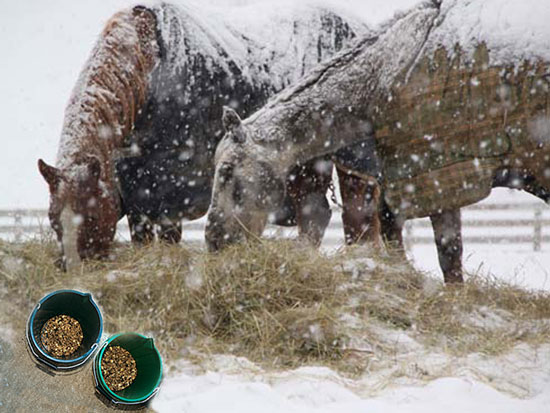February 2013 - Carbohydrates in the horse's ration
The article explains why carbohydrates in the horse's diet which originate from roughages and from grains have different effects on the horse's health and performance. The varying digestion of fibre, sugar and starch in the equine digestive system are compared, and conditions which may evolve into metabolic disease and lameness are discussed. The article is written by Dr. Dag Austbø from the Norwegian University of life sciences in Norway. He is one of the key persons who have developed the PC-Horse software.

Horses, like other herbivores, get most of the energy they need from carbohydrates in their diet. Carbohydrates are a large family of nutrients that include simple sugars such as glucose and table sugar, starch, and also complicated and indigestible plant fibres such as cellulose. The various carbohydrates are handled differently in the horse's organism, and it is therefore important to understand more about the types of carbohydrates that dominate in your horse's ration.
Generally, modern horses eat fresh or dried forages, often with the addition of grain-based concentrates. Forages include fresh grass, grass silage (haylage), hay and straw. The concentrates are either pure grains (oats, barley, maize) or mixtures based on these cereals, with other feed sources such as minerals and vitamins added. The carbohydrates in a mixed ration will therefore be derived from both roughage and concentrate components.
Roughage contains about 50 to 100 grams of sugar per kg dry feed. The rest of the carbohydrates belong to the group called fibre, and are measured either as crude fibre (about 300 grams per kg dry feed) or as soluble fibre, (NDF, about 600 grams per kg dry feed). In PC-Horse we use the crude fibre content to describe the amount of fibre in feeds.
Fibre cannot be digested by the body's own enzymes. This means that fibre is not broken down in the small intestine, but instead passes to the large intestine. Here, microbes break the fibre down in a fermentation process that takes many hours. Energy-rich products called short chain fatty acids are formed (acetic, propionic and butyric acid). The acids are absorbed into the blood and converted to chemical energy (ATP) in the cells. For horses on a forage-only diet, the fatty acids from fermentation in the caecum and large intestine are the main source of energy.
In addition to its role in supplying energy, fibre also has other important functions in the digestive tract. Fibrous feeds require a lot of chewing activity and increase the production of saliva, rich in bicarbonate buffer. This prevents undesirable acidification in the upper part of the stomach and therefore may help prevent ulcers. Since fibres are not digested in the stomach or small intestine, they will maintain volume and water content in the small intestine, and thus help to keep bowel functions healthy. A certain amount of fibre content in the diet is totally indigestible, and therefore leaves in the manure.
Carbohydrates in grain and concentrate mixtures are largely starch. The content of starch in the different grain types varies, but is typically 400-500 grams per kg dry feed. Starch is formed in plant seeds through the coupling of sugar (glucose) molecules. The starch is digested by enzymes in the small intestine and absorbed into the blood as glucose. This is the reason why you can provide your horse with energy relatively quickly through the feeding of grain or a concentrate mixture.
Glucose that is not used directly for energy after absorption is stored as glycogen in the liver and muscle, and fat in the body's fat stores. As in humans and other mammals, horses regulate their blood glucose content through the hormone insulin. Compared to many mammals, the horse has a more limited ability to control major fluctuations in blood glucose concentrations. This can cause problems for horses that have a large amount of concentrate in their ration, and requires close monitoring of the amounts of easily digestible carbohydrates (sugars and starch) that are given per meal.
There are differences in the small intestine's ability to digest starch derived from different sources. The types of grains, and different heat treatments, that are selected by concentrate manufacturers may therefore influence how quickly the starch is absorbed. Starch that is not absorbed in the small intestine is transported to the hindgut, where it is degraded by the microbes. If large amounts of starch reach the large intestine, rapid fermentation will occur. This easily leads to imbalances in the intestinal flora, with negative effects for the horse.
Carbohydrates are, as noted, the most important energy source in the horse's ration. Because of the many forms carbohydrates can take in plant material, the actual mix of carbohydrates in the total ration is important. When the carbohydrate fraction in the feed is dominated by fibre from forage, horses will benefit from ample time for chewing activities, as well as a stable intestinal function.
For active horses that need more feed, we use grain or concentrate mixtures with a high content of starch. These diets are important in rations for sport horses but, if misused, may result in problems that can ultimately lead to muscle disease and lameness. The person planning the ration should therefore monitor the level of concentrates used, and distribute them over a sufficient number of meals. Through systematic use of the PC-Horse program, you can plan rations so that the starch quantities are within the recommended ranges, and you will be given clear warnings if the starch content in one or more meals becomes too high. In addition, you can efficiently maximize the use of your own roughages if you know their energy value.

















